
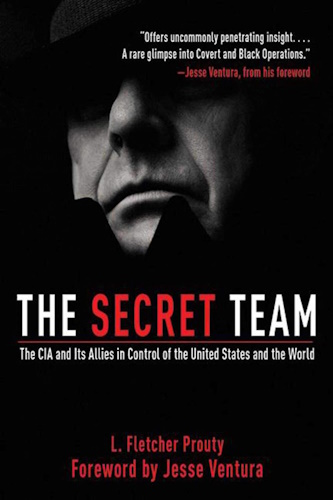
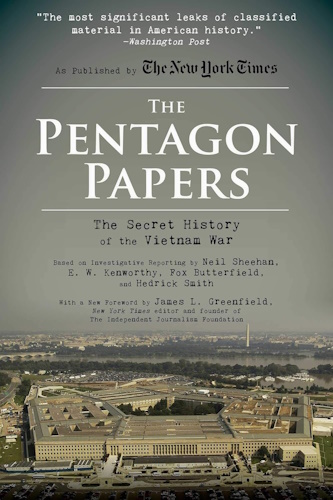

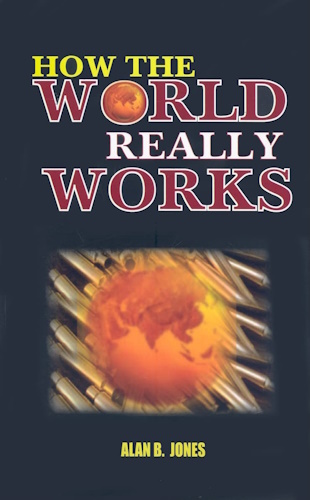

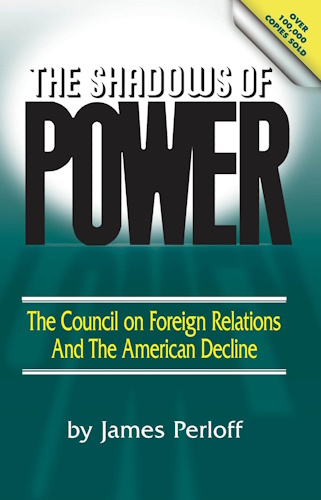

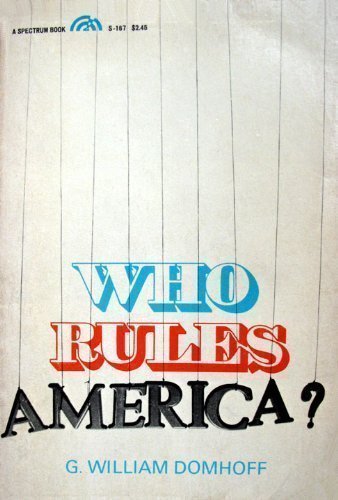

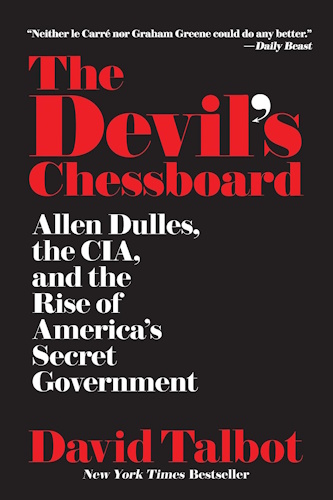
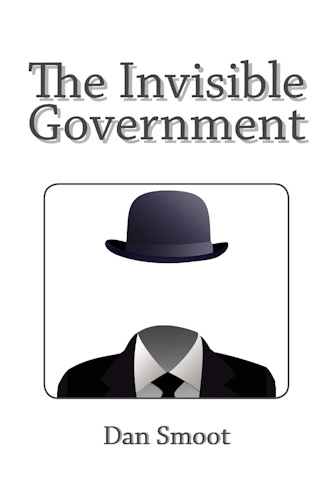

![]()
![]()
PART IV
THE CIA: SOME EXAMPLES
THROUGHOUT THE WORLD
Chapter 17
Mission Astray, Soviet Gamesmanship
HIGH OVER EASTERN TURKEY, THE BIG PLANE tossed fitfully in the turbulent air. Scattered snow-white cloud formations billowed above to thirty-five and forty thousand feet. In the brilliant sunlight and clear air between the clouds the crew could see the distant shores of Lake Van. At Lake Van they would turn to the southeast to cross near Lake Urmia and then on to Tehran. All was going well, and they expected to be in Tehran on schedule or perhaps a little early. The navigator was new in this remote area of the world, but he had noted that the winds were picking up, and he had alerted the pilot to watch for the turn at Lake Van: "You know, if you miss it we'll be in Russia."
Five men were up front in the pilot's compartment, and the others were in the empty cabin, relaxing. One young crew member, enjoying his first visit to the Near East, was taking pictures out of the right side of the plane. He noted one particularly high peak rising all by itself from the knot of mountains around it. The plane was cruising at about nineteen thousand feet, yet this lone majestic peak seemed almost to reach that altitude. Then it was lost from sight because of a cloud and he waited for his next chance to take another picture.
In front of them the pilot saw that they were getting quite close to the big lake, and he was preparing to turn as soon as he reached its near corner. On this highly classified mission, none of them wanted to take any chances of being too close to the Soviet Union. If what was in the heavy briefcases in a tail compartment of the plane ever fell into the hands of the Soviets, the work of many years with the U-2 in the Near East would be exposed, and the participation of those friendly Northern Tier countries would be compromised.
As Lake Van dipped under the nose of the big transport the pilot took the plane off of autopilot, gently banked it to the right, and set a course along the international airway for Tehran, which should have brought him just to the east of Lake Urmia. As he was busy realigning the autopilot he noticed far ahead, under the base of the cumulus clouds, what looked to be the shore of Lake Urmia just about where it should be, slightly to his left. Still thinking of the Soviet Union, he gave the knobs that controlled the autopilot an extra twist to bring the big bird that much more onto the safe side.
The young airman in the rear of the plane was able to get another good view of the big mountain now, off to the right rear, and was preparing to shoot another picture when he saw the first MIG coming up fast on their wing tip. When he saw another MIG and that undeniable Red Star on the big, high slab tail which is the distinguishing feature of the MIG, he dashed up to the cockpit and called to the pilot. At about that time they all could hear the "thutt-thutt-thutt" rapid fire of the MIG's cannon. With MIGs riding just off the right wing tip, the pilot had no choice but to detach the autopilot and veer slightly to the left. Then his co-pilot noticed the Russian pilot motioning them downward. He told the pilot, who cut the power a little and continued to bank left. In this maneuver they began to come full circle, and just as they thought they might be able to slip into a nearby cloud the whole plane shuddered and the men in the cabin saw the left inboard engine burst into flames. Another MIG flying just under their belly had given them a convincing burst of fire in the left engine nacelle.
Without waiting, five of the nine men on board donned parachutes, jettisoned the big main door as soon as the pilot decompressed the cabin air pressure, and bailed out. All of these men landed safely but were burned by flying droplets of molten metal coming from the burning engine. The other four men had no choice but to stay with the plane. With the MIGs flying only a few feet off their wing tips, they gently let the burning plane settle toward the fields below. It was then that the pilot noted a small unfinished airstrip in the farm land. He leveled off and eased the plane toward the only safe haven he could see. As he approached this small landing strip, he noticed that the grass was leaning toward his line of flight and that wind in the few small trees indicated that he would be landing downwind. This meant a fast landing on a small strip; but he did not dare to pull the plane up and try again. He could see the flames in the white-hot inboard engine, and he knew that the wing would fold up and drop off in a few more minutes. He cut his power, dropped the gear, and dropped full flaps, all as fast as he could, and drove the big plane into the ground, planning to bring it to a halt with brakes and luck.
The plane stopped skidding, far out into the field, beyond the end of the unfinished runway. It had been a rough landing, but they were on the ground. Now they had to get out of the plane right away. Because of the tail wind, the fire around the engine was blowing forward and had begun to engulf the entire wing and cockpit area in billowing smoke. The fuel tanks in the outer wing would be the next to go -- and that would be some explosion. The four men on the plane didn't wait to put the ladder down from the cabin doorway which was about nine feet in the air. They swung from the emergency rope and slid to the ground, then ran away from the plane as fast as they could. As they ran they saw smoke billowing above the plane. The MIGs swirled above them as much as to say, "Stand where you are. We're watching." Just as they stopped running they saw where the five parachutes had settled to the earth a few miles away. All nine men had landed. All nine wondered where they were.
In Washington I had just been home for about an hour and had started a charcoal fire in the backyard. The steaks were ready, and my wife and I were finishing a drink on the patio when the telephone rang. My young daughter answered the phone and then called to me, "Mr. White wants to speak to you, Daddy." I picked up the phone, and Mr. White turned out to be General Thomas D. White, then the Chief of Staff of the U.S. Air Force. He did not want to discuss the subject on the telephone, but suggested that I go directly to Allen Dulles house and do whatever I could to help him with a grave problem that had arisen.
In a few minutes I was on the way to Mr. Dulles' home. I pulled into his driveway just before dark, and as I walked through the house to his study I noted four men finishing a tennis match on the court in the rear of the house. Allen Dulles had on a vee-necked tennis sweater with white tennis shorts and peaked hat. He quickly introduced me to Dick Bissell and some of the others who were there and then began to tell me about their problem.
American newsmen in Moscow had been saying that a USAF aircraft was down somewhere in the Soviet Union. This report had been coming in from Moscow for more than eighteen hours. No one had been able to confirm or deny it. The President wanted an answer one way or the other without fail. A check of all Air Force aircraft showed that none were missing and that none were known to be anywhere near the Soviet Union. The other services and all other operators of large transport aircraft that might have been in that area were checked. No aircraft were missing. Quiet requests had been made to the CIA station chiefs in other countries to see if there might have been a foreign plane of a U.S. made type that could have gone down in the Soviet Union. For eighteen hours all of these checks had proved to be fruitless; yet the story from Moscow persisted. It was apparent that the Russians knew more than they had released, and that they were letting someone stew over the problem. A picture of a four-engined aircraft was given to the press and had been radio-photographed to the States. It showed a large plane burning in the last stages of destruction. About all that was left was the towering tail section. (Since the wind had blown from the rear, the fire had burned the front and the wings where the fuel cells were located and had left no more than the high tail section.) This gave little to work on; yet it was quite obviously the tail of a DC-6 or military C-118.
After I talked with them for a while and listened to all of the news they had, I excused myself and went to the Pentagon. In my office there was a top secret safe with a special card file on a great number of the seven-thousand-odd men who worked with me all over the world in special activities that were generally related to the support of the CIA. It consisted of a code of names, numbers, and other information that was indispensable. I took this box of cards and went down into the basement of the Pentagon, to the Air Force Command Post. This is one of the finest communications centers in the world. The duty officer authorized me to enter and to take over one of the telephone positions there on a matter of urgency.
In a few minutes I had reached the home, in Germany, of an Air Force officer who might be able to tell me about a C-118 aircraft that was not in the Air Force inventory and which might be the one that was missing. The plane I was looking for was one that belonged to the CIA itself and one of two considered to be Mr. Dulles' personal planes. I had called this officers' home in Germany by private commercial lines to bypass the military center in Frankfurt. There would be time for them later.
It was about four in the morning then in Weisbaden when the phone was answered by the housekeeper. The officer was not home. I asked where he was and learned simply that he had gone on a flight. This was part of the answer I needed. I called another Air Force officer, one who was a cover type. He told me that the plane was away on a trip. I stopped him there and asked him to go immediately to headquarters and to call me from there on the secure scrambler telephone.
About twenty minutes later the security phone rang, and he told me that General Cabell, the Deputy Director of Central Intelligence, had arrived in Germany a few days earlier in the special C-118. He had authorized a CIA/Air Force crew to take the plane on a very highly classified and important flight to Tehran and Pakistan. Cabell had gone on to England in a smaller plane, and the nine Agency men had taken the big plane to Cyprus, then to Adana, Turkey and thence to Tehran. He was advised to get the names of the nine men involved while I called Adana.
The next call was to the duty officer at Adana. He was asked to check the records there for the C-118. After a few moments he said that no C-118 had come through Adana on the day in question. He was asked to check again and to query the operations office people even if he had to wake them up one at a time. The plane must have gone through there. Fortunately, he started his search by talking with the weatherman on duty. He had been on duty when the C-118 had left Adana. The meteorologist remembered the crew and the plane. Still they could find no record of the flight. Finally, the duty officer checked the on-duty operations officer to see if perhaps he had held out the clearance papers for that flight. This did the trick. A few minutes after I had gotten the complete crew list from my contact in Germany, a call from Adana came in, stating that the pilot of the C-118 had told the operations officer not to file the clearance he had made but to hold it. This was done frequently on such black flights, and it accounted for why no one had missed the plane. Ordinarily, any overdue Air Force aircraft would be the subject of an alarm and search within one hour after its last report of position. The people at Adana did not know where the plane was going and the people at Tehran did not know that it was expected; so once the plane -- this plane of all planes -- had taken off, no one had monitored the flight at all. Its singular disappearance had gone completely unnoticed, even to the extent that it was not included on the Air Force master inventory or on the DOD master list of all military aircraft.
Having pieced this much together, I called Allen Dulles on the direct line to his home and told him that the plane we were looking for was General Cabell's plane, but that Cabell was not aboard. Within minutes, even at that hour, he was on the phone to his brother, who in turn passed the word on to the White House.
After a few hours rest, I drove back into town and stopped at Allen Dulles' house, picked him up and went to Foster Dulles' house, where we met the Secretary of Defense, at that time Neil McElroy, and the Chief of Staff of the Air Force, General Thomas D. White. The CIA had confirmed that nine men were on the plane, that it had left Adana for Tehran, and that the men had with them aboard the plane some most highly classified material in heavy briefcases. There was nothing to do but announce that a military transport aircraft on a routine trip had been blown off course on its way from Adana, Turkey, en route to Tehran and that it had landed in the Soviet Union south of Baku. At that time we knew no more than that, and we did not know that the plane had been shot down. The Secretary of State picked up the direct telephone to the White House and spoke with the President. The 'official' version of the story was released with the hope that there would be no necessity to elaborate further. However, this would depend upon the identification carried by the crew members and on whether or not the classified materials and other items that might have identified the CIA would be uncovered.
It was not long before the Russians released the story that the big plane had violated its airspace and that MIG fighters had forced it down as it attempted an escape maneuver, by firing a warning burst into the left wing. What we did not know at the time was that the pilot and other crew members had mistaken Lake Sevan for Lake Van. This meant that a greater than expected tail wind had blown them off course to the left and at the same time had put them ahead of schedule. Because of the clouds they missed Lake Van, and with Lake Sevan in sight they felt no concern. They were sure they were on the right course. The CIA had utilized a crew for this flight who did not know the area well, and confusion is not uncommon for a new crew in a strange place. Then, with Lake Sevan as their mistaken turning point they did see water ahead, which looked like Lake Urmia. Not being familiar with Lake Urmia, a larger lake, they mistook the distant shoreline of the Caspian Sea for Lake Urmia and thought all was well. Actually, on this windblown course, they were well inside the Soviet border, somewhat south of Baku,
The key to their mistake was discovered later, when all of the crewmen were questioned and the young airman in the cabin who had been taking pictures told us about the huge mountain off to their right. That was Mount Ararat, over sixteen thousand feet in altitude and the highest peak in the area. Mount Ararat should have been far on their left, and they should have turned to the southeast before they ever got near Ararat. When the airman revealed that he had photographed Mount Ararat through the right window -- looking to the south -- before the turn, and then had seen it again through the same right window after the turn -- thus to the east -- it became indisputably clear that the plane had passed north and then well to the east of Mount Ararat. This was far off course and over Soviet territory.
Another thing we did not know was that as the men in their parachutes were descending they all realized that they were carrying considerable identification, including reference to their USAF "cover" unit that might have compromised them; so they began to clean out their pockets and tear up all they could while going down. Later, they learned that Russian farmers noticed this hail of bits and pieces and that the local police had rounded up scores of people, located most of this evidence, and reassembled it during their captivity in Baku.
Another thing that became evident from the selected pictures the Russians chose to release was the fact that the C-118 did not burn completely; the part that remained after the tail-wind landing was the entire rear of the plane -- where the classified briefcases were. Tests on such briefcases had shown that they could sustain considerable heat and some flame without appreciably damaging the documents inside. The chances were very good that the entire classified cargo had been recovered intact.
This may have saved the men from lengthy captivity. Knowing that they were doing nothing more than transporting briefcases, and that most likely they were little more than a crew and not true agents, the Soviets may have reasoned that it was better to release the men early. That would imply they really believed the men were simply transport crewmen, and it would lead us to attempt to find out how much the Russians might have gained through the unscheduled gratuity of the briefcases. The men were held for nine days, and during this time they were questioned continually. The Russians learned all they needed to know and then let the crew go without too much delay.
One episode stands out clearly and supports the idea that they knew quite well exactly what they had captured. Aboard was an Air Force colonel and the senior officer of the USAF cover unit in Weisbaden, Germany. He was a real Air Force officer and his cover assignment was deep; but not so deep that he would have had great value to the Russians. However, they did not wish to miss any chances. After a few days in Baku the Russians approached the colonel and told him that since he was the senior officer and since it had become obvious to them that he was simply the commander of a transport unit -- his cover story -- they saw no need to have him attend the strenuous interrogations in which the other men were involved. In fact, they suggested that he might enjoy a few days fishing on the Caspian. They also told him that they had located a teacher who happened to be there on his vacation and that this teacher could speak English.
The colonel accepted this offer, and for several days he joined this male teacher on hiking and fishing trips. During this time they talked alot about the United States. It seemed that the teacher had been in Washington during World War II and that he had been a member of the Russian Lend Lease staff. The teacher was able to lead the conversation into many fields, and the colonel thought it best to speak unrestrainedly in order to establish a comfortable relationship that might help all of them to gain their release. However, upon retrospection the colonel did realize that the teacher seemed to have a most excellent insight into current American policies and practices; but in his zeal to win his cooperation the colonel tried to answer what seemed to be simple questions, even when they led at times into some areas that put a little pressure on secrecy.
When the men were released nine days after they had been shot down, a special team had been sent to the Iranian-Soviet border to provide transportation to get them back to Germany without delay. In Germany the men went through lengthy interrogations designed to be somewhat superficial so that they might let their guard down. Then when they were flown to the United States they were put through a program of intense and highly professional interrogation by teams of well-trained FBI, CIA, and military men. It was the Washington debriefing that uncovered the Mount Ararat fix, the location of the briefcases, and the fact that they most probably were not destroyed; this debriefing also developed the "school teacher" angle further. By about the fifth day of debriefing, the combined FBI and CIA team1 was able to lay a set of pictures on the table before the colonel and with apparent ease show him several very good pictures of the "school teacher". This "vacationing school teacher" was none other than one of the top intelligence men of the Soviet Union. He had been with the Russian staff in Washington during the Lend Lease period in World War II. The very fact that this man himself participated in this mild interrogation on the shores of the Caspian made it quite clear that the Russians had found out that they had made a big catch in the capture of this one plane.
This whole incident in some ways presaged the U-2 affair and in some ways offered clues to other events that followed. The CIA was getting to the point where it took operational matters into its own hands. There was no reason whatsoever why the highly specialized and sanitized C-118 should have been used on a mission close to the Soviet border. Any Air Force aircraft could have been used. Certainly the Russians combed the remains of the plane and found a number of odd features, among them totally unsanitized and "unmarked"2 component parts.
There was no reason whatsoever to utilize an inexperienced CIA crew on this flight, when the Air Force had a number of crews that were very familiar with the Gordian Knot area of remote Turkey. Actually, there is an effective radio beacon homer at the southern tip of Lake Van, and an experienced crew would have used it properly. For example, the navigator on this CIA crew had not been in this area before and another navigator who was with him had not been there for a very long time.
Perhaps the most damaging oversight, which must have confirmed for the Russians that they had caught a pretty special breed of fish, was that the CIA used unnecessary secrecy with respect to fight clearances of the plane. There was no good reason why the plane, which looked just like a regular Air Force plane, should not have used the customary landing and take-off clearances that all Air Force aircraft use the world over. This would have assured that the flight would have been monitored. Under such regulations the Air Force would have noted the silence of that plane within thirty minutes, and in any case within one hour after its last contact with a ground station. This is standard procedure. Had this been done, a search would have been started right away. Then the Secretary of State and the President would not have had to deny that a plane was missing for a full eighteen hours, while the Russians knew all that time exactly what had taken place. They had the men, the plane and the briefcases. It might be added that a normal part of an Air Force clearance requires confirmation that the crew is competent and has been over the route recently.
Failure of the entire U.S. Government to respond to the reported loss of this aircraft certainly signaled to the Russians that this plane must have been on a special mission, if nothing else did. One year later this same thing happened when the U-2 was lost. At first the United States did not know just where the U-2 had been lost. Then, when it was realized that it was down in Russia, it was assumed that the pilot was dead; so a cover story was used, only to have Krushchev blow it up when he surfaced a live pilot and a nearly whole aircraft, both in Soviet hands.
It goes without saying that the CIA compounded the problems of this incident by permitting a most highly secret cargo to be entrusted to this plane and crew, when it could have set up a more secure and less casual means of transportation even if it had used a normal commercial air carrier. Such disregard for real professionalism, in favor of a growing dependence upon its new-found strength, independence, and size, became more marked as the years passed.
Footnotes
1. Headed by the same James McCord later to gain notoriety in the 1972 "Watergate" affair.
2. Industrial components are marked with special numbers, codes and other identifying inscriptions. A thorough intelligence system classifies these things and can gain considerable information from such data. (More later.)












-
Urantia Book, 44:0.11 - The Celestial Artisans
Never in your long ascendancy will you lose the power to recognize your associates of former existences. Always, as you ascend inward in the scale of life, will you retain the ability to recognize and fraternize with the fellow beings of your previous and lower levels of experience. Each new translation or resurrection will add one more group of spirit beings to your vision range without in the least depriving you of the ability to recognize your friends and fellows of former estates.
-
Princess Bride 1987 Wallace Shawn (Vizzini) and Mandy Patinkin (Inigo Montoya)
Vizzini: HE DIDN'T FALL? INCONCEIVABLE.
Inigo Montoya: You keep using that word. I do not think it means what you think it means. -
Urantia Book, 117:4.14 - The Finite God
And here is mystery: The more closely man approaches God through love, the greater the reality -- actuality -- of that man. The more man withdraws from God, the more nearly he approaches nonreality -- cessation of existence. When man consecrates his will to the doing of the Father's will, when man gives God all that he has, then does God make that man more than he is.
-
Urantia Book, 167:7.4 - The Talk About Angels
"And do you not remember that I said to you once before that, if you had your spiritual eyes anointed, you would then see the heavens opened and behold the angels of God ascending and descending? It is by the ministry of the angels that one world may be kept in touch with other worlds, for have I not repeatedly told you that I have other sheep not of this fold?"
-
Urantia Book, Foreword - 0:12.12 - The Trinities
But we know that there dwells within the human mind a fragment of God, and that there sojourns with the human soul the Spirit of Truth; and we further know that these spirit forces conspire to enable material man to grasp the reality of spiritual values and to comprehend the philosophy of universe meanings. But even more certainly we know that these spirits of the Divine Presence are able to assist man in the spiritual appropriation of all truth contributory to the enhancement of the ever-progressing reality of personal religious experience—God-consciousness.
-
Urantia Book, 1:4.3 - The Mystery Of God
When you are through down here, when your course has been run in temporary form on earth, when your trial trip in the flesh is finished, when the dust that composes the mortal tabernacle "returns to the earth whence it came"; then, it is revealed, the indwelling "Spirit shall return to God who gave it." There sojourns within each moral being of this planet a fragment of God, a part and parcel of divinity. It is not yet yours by right of possession, but it is designedly intended to be one with you if you survive the mortal existence.
-
Urantia Book, 1:4.1 - The Mystery Of God
And the greatest of all the unfathomable mysteries of God is the phenomenon of the divine indwelling of mortal minds. The manner in which the Universal Father sojourns with the creatures of time is the most profound of all universe mysteries; the divine presence in the mind of man is the mystery of mysteries.
-
Urantia Book, 1:4.6 - The Mystery Of God
To every spirit being and to every mortal creature in every sphere and on every world of the universe of universes, the Universal Father reveals all of his gracious and divine self that can be discerned or comprehended by such spirit beings and by such mortal creatures. God is no respecter of persons, either spiritual or material. The divine presence which any child of the universe enjoys at any given moment is limited only by the capacity of such a creature to receive and to discern the spirit actualities of the supermaterial world.
-
Urantia Book, 11:0.1 - The Eternal Isle Of Paradise
Paradise is the eternal center of the universe of universes and the abiding place of the Universal Father, the Eternal Son, the Infinite Spirit, and their divine co-ordinates and associates. This central Isle is the most gigantic organized body of cosmic reality in all the master universe. Paradise is a material sphere as well as a spiritual abode. All of the intelligent creation of the Universal Father is domiciled on material abodes; hence must the absolute controlling center also be material, literal. And again it should be reiterated that spirit things and spiritual beings are real.
-
Urantia Book, 50:6.4 - Planetary Culture
Culture presupposes quality of mind; culture cannot be enhanced unless mind is elevated. Superior intellect will seek a noble culture and find some way to attain such a goal. Inferior minds will spurn the highest culture even when presented to them ready-made.
-
Urantia Book, 54:1.6 - True And False Liberty
True liberty is the associate of genuine self-respect; false liberty is the consort of self-admiration. True liberty is the fruit of self-control; false liberty, the assumption of self-assertion. Self-control leads to altruistic service; self-admiration tends towards the exploitation of others for the selfish aggrandizement of such a mistaken individual as is willing to sacrifice righteous attainment for the sake of possessing unjust power over his fellow beings.
-
Urantia Book, 54:1.9 - True And False Liberty
How dare the self-willed creature encroach upon the rights of his fellows in the name of personal liberty when the Supreme Rulers of the universe stand back in merciful respect for these prerogatives of will and potentials of personality! No being, in the exercise of his supposed personal liberty, has a right to deprive any other being of those privileges of existence conferred by the Creators and duly respected by all their loyal associates, subordinates, and subjects.
-
Urantia Book, 54:1.8 - True And False Liberty
There is no error greater than that species of self-deception which leads intelligent beings to crave the exercise of power over other beings for the purpose of depriving these persons of their natural liberties. The golden rule of human fairness cries out against all such fraud, unfairness, selfishness, and unrighteousness.



